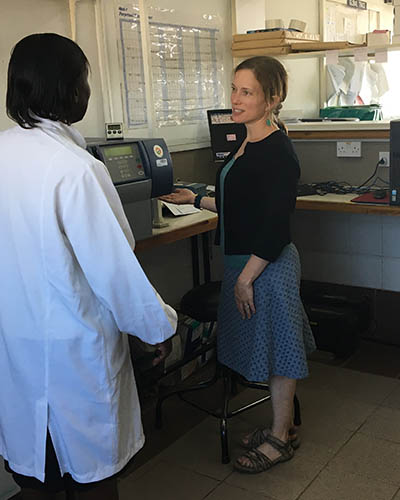September 22, 2017 | joanne Morrsion

Targeting Pregnant Women Against Malaria Through Vaccination Could Protect Infants
Malaria is a major cause of death for children throughout sub-Saharan Africa. In this high transmission area, they are at risk of severe malaria early in life when their immune system has not developed enough to protect them.
While developing a malaria vaccine has become a global public health priority, the first vaccine to reach Phase 3 trials and licensure (RTS.S) has been less effective in infants compared to older children, suggesting that an alternative approach is needed to protect this most vulnerable age group.
Research conducted by University of Maryland School of Medicine in Malawi showed the potential for protecting infants from malaria before they are born by vaccinating pregnant women. Led by Miriam Laufer, MD, MPH, Director of UM SOM’s Division of Malaria Research, researchers studied the transfer of antibodies from mother to fetus in 33 mother-infant pairs. Using a unique microarray approach developed by UM SOM they were able to determine that the full range of antibodies that the mother has against malaria are passed to her infant prior to delivery.
It is known that antibodies in a pregnant woman’s blood pass across the placenta into the fetus, giving the baby some protection against infections at birth. But what UM SOM researchers discovered in their research published in Clinical and Vaccine Immunology is that mother and infants had the same repertoire of antibodies to malaria. What this means is that an infant’s antibodies can recognize the same range of malaria surface proteins. This is critical because malaria parasites have different forms of surface proteins that they can express, and in order to be protected against malaria infections, the immune system must recognize several different forms of each of the proteins.
Furthermore, the research showed that malaria infection in the placenta did not interfere with the passage of antibodies across the placenta.
“Our research shows that if we boost the mother’s immune responses to malaria, such as through vaccination, the infant will be better protected against infection,” said Dr. Laufer. “This is critical because young children are at highest risk of dying from infectious diseases such as malaria. In addition, if we can prevent infection during infancy, this may help ensure healthy growth and cognitive development in infants and young children.”
Using a Unique Microarray Platform to Track Malaria Strains
The research in Malawi, followed pregnant women from 20-26 weeks into gestation through delivery. This included monthly routine visits and evaluations when they were sick. Researchers collected specimens from mothers and from the umbilical cord attached to the placenta at delivery. Using the serum they collected, they were able to map the antibody responses malaria surface proteins that were present in both the mother and infant, using a unique microarray platform.
"Our study underscores the importance of reaching out to women during pregnancy. This is a rare time when adults regularly encounter the healthcare system and interventions introduced during pregnancy have the potential to improve the health of both the mother and child," said Sarah Boudova, PhD, an UM SOM researcher in the Division of Malaria Research and lead author of the research paper.
It is the first study to employ this high throughput protein microarray to compare maternal and newborn responses, allowing researchers to analyze infant blood serum reactions to a large and diverse group of potential vaccine antigens and thoroughly characterize the effectiveness of trans-placental antibody transfer.
Typically, when researchers look at immune response to malaria, they use malaria parasites that have been adapted to grow in the laboratory. However, these are not necessarily similar to the parasites seen in nature. This is why past vaccine developments using laboratory strains of malaria have not been effective in protecting against a wide range of malaria strains. This led UM SOM the research team to create platforms to characterize the diversity of malaria parasite surface antigens through genomic tools and develop custom-designed assays that allowed them to assess immunological responses to these diverse proteins.
“We now know that trans-placental antibody transfer is highly efficient. If we want to better protect infants from malaria, we could target pregnant women to be vaccinated so that their antibody levels are higher, leading to higher levels in the infant,” said Dr. Laufer, noting that this strategy has already been applied for influenza and pertussis.
“Malaria is a leading cause of death in sub-Saharan Africa, and our research here at the University of Maryland School of Medicine will help protect the most vulnerable populations from this terrible infectious disease,” said E. Albert Reece, MD, PhD, MBA, vice president for medical affairs at the University of Maryland and the John Z. and Akiko K. Bowers Distinguished Professor and dean of the University of Maryland School of Medicine. “Our researchers use cutting edge science to better understand malaria and eventually eliminate it.”
About the University of Maryland School of Medicine
Commemorating its 210th Anniversary, the University of Maryland School of Medicine was chartered in 1807 as the first public medical school in the United States. It continues today as one of the fastest growing, top-tier biomedical research enterprises in the world -- with 43 academic departments, centers, institutes, and programs; and a faculty of more than 3,000 physicians, scientists, and allied health professionals, including members of the National Academies of Science, Engineering and Medicine, and a distinguished recipient of the Albert E. Lasker Award in Medical Research. With an operating budget of more than $1 billion, the School of Medicine works closely in partnership with the University of Maryland Medical Center and Medical System to provide research-intensive, academic and clinically-based care for more than 1.2 million patients each year. The School has over 2,500 students, residents, and fellows, and nearly $450 million in extramural funding, with more than half of its academic departments ranked in the top 20 among all public medical schools in the nation in research funding. As one of the seven professional schools that make up the University of Maryland, Baltimore campus, the School of Medicine has a total workforce of nearly 7,000 individuals. The combined School and Medical System (“University of Maryland Medicine”) has a total budget of $5 billion and an economic impact of nearly $15 billion on the state and local community. The School of Medicine faculty, which ranks as the 8th-highest public medical school in research productivity, is an innovator in translational medicine with 600 active patents and 24 start-up companies. The School works locally, nationally, and globally, with research and treatment facilities in 36 countries around the world. Visit medschool.umaryland.edu/.
About the Division of Malaria Research
The Division of Malaria Research (DMR) aims to support global malaria eradication efforts by developing and deploying innovative tools for improved malaria treatment, prevention and surveillance. In its molecular parasitology and immunology laboratories in Baltimore and at field research sites across Africa and Asia DMR leads clinical trials of malaria drugs and vaccines and investigates antimalarial drug resistance, molecular and genomic epidemiology, immuno-epidemiology, pathogenesis, malaria in pregnancy, and interactions between malaria and co-infections including HIV and schistosomiasis. http://www.medschool.umaryland.edu/malaria/
Learn More
Contact
Office of Public Affairs
655 West Baltimore Street
Bressler Research Building 14-002
Baltimore, Maryland 21201-1559
Contact Media Relations
(410) 706-5260
Related stories

Wednesday, August 02, 2017
UM School of Medicine Receives $2 Million Grant for HIV Research in Malawi
The University of Maryland School of Medicine’s (UM SOM) Institute for Global Health (IGH) and the Institute of Human Virology (IHV) have been awarded a $2 million five-year grant from the Eunice Kennedy Shriver National Institute of Child Health and Human Development to study the impact exposure to HIV has on the immune systems of infants in utero and how those changes impact the ability of infants to fight off infections after birth.

Monday, March 20, 2017
Pediatric Infectious Disease Specialist, Dr. Miriam Laufer, to Head Division of Malaria Research at the University of Maryland School of Medicine
Christopher Plowe, MD, MPH, the Frank M. Calia Professor of Medicine at the University of Maryland School of Medicine (UM SOM), and director of the UM SOM Institute for Global Health (IGH), as well as UM SOM Dean E. Albert Reece, MD, PhD, MBA, announced today that Miriam K. Laufer, MD, MPH, will be the new Director of the Division of Malaria Research (DMR) at IGH.
